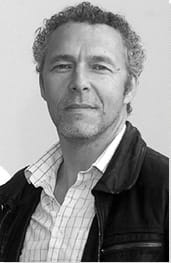Summary of Julian Opie
Opie's art is instantly recognizable for a distinctive "clean" and pared-down graphic style that reflects his fascination with the ways viewers perceive and interact with their everyday world via signs and images. Drawing on influences as wide-reaching as classical portraiture and sculpture, Egyptian hieroglyphs, Japanese woodblock prints, and public signage such as information boards and traffic signs, his art has been realized through screen-printing, LED screens, billboard posters, and album covers. Opie is also recognized as a member of the New British Sculpture Group, under whose banner he produced irreverent sculptures based on famous works of art, featuring everyday objects.
Accomplishments
- Opie is probably best known for his graphic portraiture that aims for no more than a broad likeness to his sitter. His use of computer aided design means that his portraits move freely between the domains of contemporary art and commercial design. Through his portraits, Opie creates the sort of uniformity one might find in passport portraiture and transforms - or, rather, reduces - his subjects to almost a brand logo.
- Opie has produced a number of animated sculptures based on variations on his Suzanne Walking and Julian Walking series. Realized on LED screens, and placed in public squares and thoroughfares, the sculptures, might just as easily pass as regular street signs, but Opie's intention is to make viewers pause to consider the works and how they connect the artificial with the human.
- Like his portraits, Opie's landscapes (both rural and urban) are rendered in his trademark minimalistic style. He uses thick black outlines with features such as trees and hills reduced to the simplest blocks of colour and line. His aim is to recreate the kind of landscapes one might find in computer car racing games (such as empty, curving roads, edged with nondescript greenery against a flat blue sky). Opie says, "You know there is a tendency to feel that in order for something to be important that it's got to be difficult, and I tend to go the other way".
- Opie's simple and immediate style has lent itself also to several public projects including airports; prisons; and hospitals. For the Lindo Wing of London's St. Mary's Hospital (2012), for instance, he produced stark black pictograms on glass panels that suggest animated movement through the building's corridors and across its five levels. Opie's goal was to emphasize the idea that movement is essential to human life and an especially appropriate message to convey in a place dedicated to the preservation of life and healing.
The Life of Julian Opie
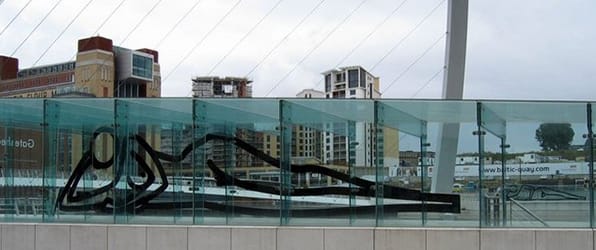
Opie once said of his art that it is "like advertising", and while acknowledging that it can be "annoying and intrusive [like] a loud radio on the beach", he always aims "to please and amuse and intrigue ... like a street juggler".
Important Art by Julian Opie
Making It
Opie's earliest works were steel sculptures painted with oil. These pieces aimed to resemble everyday objects such as tools, appliances, furniture, and food. Making It is painted to look like a vertical stack of wooden boards, with a number of tools precariously embedded/balanced including a hammer, handsaw, electric drill, and screwdriver. The objects are not painted to look photorealistic, but rather like detailed and finely-shaded illustrations. Opie has said of Making It, "it is a self-conscious sculpture. It's aware of itself being made and that makes it into a very different thing. The tools swamp the conventional wooden sculpture, in the same way that being aware that you are making art changes the art". He added that these pieces were a direct riposte to the trend in 1970s sculpture, "a lot of which tried to iron out any sign of human interference".
These pieces were the first to launch Opie into the public eye and helped position him within the New British Sculpture movement with the likes of Tony Cragg, Anish Kapoor, Richard Deacon, Anthony Gormley, Shirazeh Houshiary, and Richard Wentworth. Although theirs was a diverse range of styles, all the artists were reacting against the dominant trends of Minimalism and Conceptual art. As Tim Woods, professor of English and American Studies, explains, the work of the New British Sculpture movement was unified by four main themes: "(a) a synthesis of pop and kitsch, (b) a bricolage (assemblage) of the decaying UK urban environment and the waste of consumer society, (c) an exploration of the way in which objects are assigned meanings, and (d) a play of colour, wit and humour".
Oil paint on steel - Tate, London, England
Gary, Popstar
By the late 1990s, Opie had established his signature portrait style. Paintings such as Gary, Popstar feature thick lines and minimal details that create a broad likeness of the sitter. Opie's portraiture process usually begins with a quick (fifteen to twenty minute) photography session with the subject. He says, "I generally need to see people's nostrils, so a lot of the photographs are taken from a little lower down, and I ask them not to smile. I relish people's self-consciousness when they're being photographed. I want them to look as if they were being painted". He then uploads the photographs onto his computer, imports them into Adobe Photoshop, and from there into Adobe Illustrator, a program that allows him to create a basic digital drawing using the photo as a guide. He created several versions of Gary, Popstar, including some black and white, some with color, and some with Gary wearing sunglasses, a beaded necklace, and different hairstyles.
Opie's portraits usually include dots for eyes, two more small spots as nostrils, and eyebrows and mouths created with simple strokes. His main inspiration for this aesthetic comes from the Tintin cartoon by Belgian cartoonist Hergé. Arts researcher Elizabeth Manchester notes the influence of important Pop artists on Opie's work, such as Roy Lichtenstein, who brought "cartoon and comic-book imagery [...] into the realm of high art," Andy Warhol, who pioneered "standardized or industrialized portraiture (involving different coloured versions of the same image)," and Patrick Caulfield who "began painting objects as blocks of pure colour outlined in black".
Manchester argues that "By applying this process of commercial commodification to his work, Opie would seem to be aiming to please the viewer and cater for all possible tastes". But Opie himself supplied a caveat to that assumption when he stated, "My instincts are always to do what's easiest - that's just a rule that I follow and it means that you often end up making things that some people, and even I myself can feel a little dubious about. When people find out that I use photography as the basis for my portraits you can see that they feel a slight sense of disappointment, but frankly a photograph makes it a hell of a lot easier and we all know that the Dutch painters in the 17th century used the Camera Obscura when they could".
Screenprint on paper - Museum of Modern Art, New York
Imagine You Are Driving
This work, an early screen print by Opie, comes from his Imagine You Are... series, in which he explored simplified landscapes. He specifically aimed to recreate the sorts of landscapes found in computer car racing games, though he also based the works on photographs he took during a road trip across Europe in 1993. Art historian Lucy Howie explains that by the end of the 1990s, Opie had developed a "strong interest in landscape and how natural features such as trees and hills can also be reduced to blocks of colour and line. The Imagine You Are... series features images of an empty road; curving away from the viewer it is flanked by nondescript greenery and framed by a flat blue sky. Simplified to its essentials, the works [...] seem to invite the viewer to fill the rest in for themselves".
Says Opie, "In the 90s the computer was providing a rapidly growing public language that was fresh and new, and kind of thrilling. I was seeing shop windows in [London's] Tottenham Court Road with all the computer screens with screensavers on them, and it was a real shock to seeing a moving, three-dimensional image that was a drawing. It simply hadn't been possible. It was an utterly new way of looking at things and yet, it obviously came from somewhere - it reminded you of Bauhaus drawing and Russian constructivism but it was still entirely new".
Commenting on the series for the Tate Gallery, Manchester observed that the works simulate not just "the symbolic landscape of computer games", but also, "children's picture books [that] encourages the viewer to journey into a stylized representation of the world, emptied of human presence". Opie himself said of the landscapes, "what I would really like to do is make a painting and then walk into it [and] I think my work is about trying to be happy ... I want the world to seem like the kind of place you'd want to escape into ... Mundane things are just as exciting as all the things you might imagine escaping into". Manchester comments that Opie "suggests that the processes of his work may have an idealising or utopic function, which is belied by the blank emptiness of his imagery". However, his "visual symbols and his system of commodification suggest that the utopic ideals represented by these systems may result, paradoxically, in dehumanising alienation".
Screenprint on paper - Tate, London, England
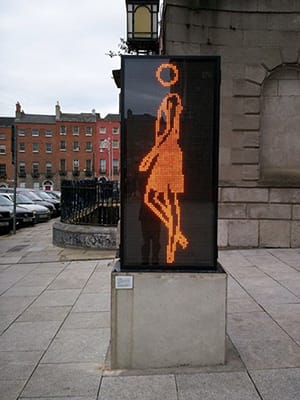
Suzanne Walking in Leather Skirt
Opie has created a number of simple computer animations, some of which, including variations of Suzanne Walking, have then been transmitted as continuous loops on LED screens in public spaces, including the Northern Avenue Pedestrian Bridge in Boston, and Parnell Square in Dublin. These recall the format of street signs (such as the little man/woman icons at crosswalks that tell us when it's safe to cross), with bodies formed by simple lines, and heads represented by a circle. In combining the iconic signage found throughout our public spaces, with imagery based on real individuals, these works explore the intersection between the artificial and the human.
While the works may seem unsophisticated, Opie's process for understanding and representing the figure's movement was rather intensive. He had his model walk on a treadmill at varying speeds, which he videotaped. Opie then imported the videos onto his computer, and selected certain frames that, when combined, would give the illusion of natural movement. Finally, as with his portraits, he used each still image as a guide for his drawings. Through this process, he was able to capture the particularities of the individual model's gait. For instance, Suzanne's stride comes across as sensuous and feminine, while a complementary series, titled Julian Walking, shows a male figure whose movement is heavier and more cumbersome.
Two side animated LED display - Parnell Square, Dublin, Ireland
Sissi Looking Upwards
More recently, Opie has felt compelled to explore the nuances of human expression and movement. He says, "To be able to draw the subtle movements of the face, I had to find a new way of drawing. I looked at Japanese manga and old master paintings to understand how shadows instead of lines could be used for drawing. I used a 19th century invention with grooved lenses that gave the illusion of movement when you walked past a painting. As with the classic haunted house paintings, whose eyes follow you, I can make my portraits respond to the viewer. It's a simple trick that doesn't fool anyone, but nevertheless breaks the rules of reality. Magic is an important part of art and allows the image to break out of normality and bring communication, language, to life". The "lenticular" printing method, as art historian Lucy Howie explains, involves the artist creating "a sequence of drawings, as if for animation, which are then layered on top of one another to create the illusion of movement when the viewer moves, and remain still when the viewer is still".
This work comes from a series of lenticular prints featuring Opie's own daughters. Indeed, many of his most creative and engaging works have developed out of his fascination with the way in which his children explore and observe the world. In this vein, he also created a number of Sheep sculptures, which were inspired by wooden animal toys that he brought back from Vienna once as a gift for his infant daughter. He liked that the toys were both "images and objects", and he saw that his daughter had fun moving them around, as if the carpet of their home were a field. He then connected these animal objects to the human realm and made them into powder-coated aluminum sculptural works that could be installed inside or outside, in order to animate the spaces in which we exist.
Lenticular inkjet print on transparent synthetic polymer resin - National Gallery of Victoria, Melbourne, Australia
Lucia, Back 2
As part of his creative process, Opie often spends hours photographing passers-by in public spaces. After decades of keenly observing human behavior, he became interested by the idea of someone refusing to have their portrait taken, thus, as he puts it, "refusing your gaze". He explores this idea in Lucia, Back 2, believing that an image of someone "turning away" gives the viewer the feeling that they're behind this person in a queue. When compared to his commissioned, frontal portraits, the relationship between the viewer and the viewed changes significantly. Opie suggests that there is a sort of "melancholic drama" to this type of relationship. He recognizes that throughout art history, there has been an ongoing presence of the acts of turning toward and turning away, as well as an exploration of what these movements mean for the relationship between viewer and viewed. (He cites the example of a 1640 self-portrait by Sir Anthony van Dyck, which has a "strong twist in the pose"). When confronted with the image of someone who is turning away, the viewer gets a stronger sense of being a voyeur.
Many works by Opie appear deceptively simple whereas the concept behind them is more complex. Says Opie, "I think I'm aware that when you make an image, a lot of what's going on there is to do with what people bring to it. Some people often talk about my portraiture being pared-down but I don't quite see it that way. I see it as starting from a point of view of saying, 'I'd like to make something, I'd like to mark my presence, I'd like to communicate what it feels like to look at things.' That's sort of a basic urge, which I'm not sure I can really explain. If you take that as a given then I just try not to go any further than what I think I understand at any one time. So, for me, the portraits that I make are quite complicated".
Aluminum, nylon, and lights
Biography of Julian Opie
Childhood
Julian Opie was born in London, and raised in Oxford. His father was the renowned Australian-born economist, Roger Opie, who was an Oxford don and a regular guest on the British television program, The Money Show. His mother, Norma, was a teacher. Opie recalls, "They were comfortable, my parents. They kind of stumbled through life".
The Opie family owned a boat and he recalled: "My Father took navigation night school classes and avidly planned trips along the English South coast. We often sailed across the channel to France and Holland. It was a small rather slow boat, and we usually hugged the coast where possible, taking most of a day to get from one port to another. It could be very boring, and we would read or catch fish. I would draw the passing views". He and his sister recreated such landscape scenes, with fields of blue separated by thin strips of green and brown, on the wall of their family's summer home on England's South Coast. He says, "We had to draw the scene over lumpy wallpaper, but the effect was quite realistic, and made a nice view from the bed".
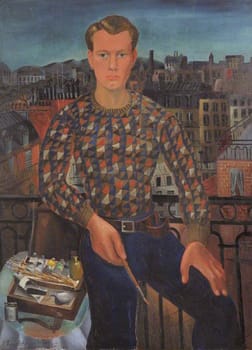
Opie attended a private preparatory school called, The Dragon School, and then Magdalen College School, in Oxford. He had been keen on art since early childhood. He was familiar with Modern art, particularly the work of the St. Ives School artists, which his parents introduced him to. By the age of ten, Opie was stretching his own canvases in his family's basement and experimenting with abstract painting. He recalls that "I knew I wanted to make art and I didn't feel embarrassed about that".
Opie won his first art prize aged twelve. He recounts, "I carved a bar of soap into a Henry Moore - it wasn't a joke and it wasn't a copy, I just knew roughly what a Henry Moore or Barbara Hepworth looked like. I guess it was a bit like a Richard Prince art joke - a bar of soap looking like a Henry Moore that you can wash with and watch disintegrate. But although I knew it was funny, I was serious about it. I don't know whether they gave me the prize thinking that it was a innocent, naïve attempt to make a work, or whether they thought I was copying Henry Moore and didn't really know it". Although many of his friends encouraged him to pursue his interest art, he thought that art school was "for losers". But it was on his mother's insistence that he eventually enrolled in the Chelsea School of Art, before moving to Goldsmith's School of Art (also in London).
Education and Early Training
At Goldsmiths he was tutored by conceptual artist and painter Michael Craig-Martin (who also taught members of the Young British Artists (YBA) group, including Damien Hirst and Tracey Emin). Opie worked briefly as assistant to Craig-Martin and the artist and curator Richard Wentworth. At this time, Opie cited his biggest influences as Carl Andre, Julian Schnabel, Bruce Nauman, and Chris Burden, but he still felt that "there was a general sense of art having become cut off from how people looked at the world". He says, "If I think of my parents after the war - they simply didn't want anything old. I suppose as children of the war I can understand that. Therefore it felt quite invigorating to become traditional, or to look at the traditions and bring those back into play. So at college I used to draw say, a hand, in the style of El Greco and write 'Eat Dirt El Greco' on top of the hand and pin it up all around the college".
Opie found London a very intimidating city, and recalled that, after graduating from Goldsmiths in 1983, he had no idea what to do. He found himself "desperately looking" around for a sense of purpose and spent some time squatting in a high-rise flat, from where he would look out over the London skyline and wonder where he might fit in.
Opie's earliest works were folded steel sculptures, which were then hand painted to represent domestic objects and appliances. These appeared in a group exhibition in 1983 (the year of his graduation) at the Lisson Gallery, situated in the fashionable West London district of Marylebone. Other artists in the exhibition included Americans Keith Haring and Jenny Holzer, as well as Indian-British artist Anish Kapoor, who was part of the New British Sculpture group. Opie had his first solo exhibition the following year, also at The Lisson Gallery (which continues to represent him today).
By the mid-1980s, Opie was starting to attract the attention of the international art world. He established his own artistic practice and formed close working relations (and friendships) with artists from the YBA and New British Sculpture groups. For instance, he exhibited with British painter and sculptor Chris Ofili, and, when he found himself with hundreds of applicants for an assistant position, Opie recommended some of the best candidates to Ofili. Opie also collaborated on artworks with his former Goldsmiths classmates Fiona Rae and Lisa Milroy.
Mature Period
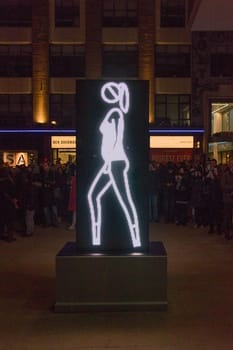
During the mid-to-late 1990s, Opie began using computer software to create images that would emulate video game graphics. He says, "In a way, it was a process very similar to early Renaissance paintings with this simplified perspective, and a lot of grey in the shadows to try and pull it out". In 2001, Opie worked with Birmingham's Ikon Gallery, turning the building as a whole into an exhibition. As the Ikon explained in its publicity for the ambitious event, Opie was making an "analogy between a journey through the exhibition into the outside world. The work included roadscape wall paintings and a new series of landscape, cityscape and seascape paintings, covering the galleries, the stairwell, the reception area, Oozells Square, Brindleyplace [in Birmingham] and a commissioned site-specific work in the glass lift shaft".
In the early 2000s, Opie produced variations in his "Imagine You Are..." series which included, Imagine You Are (Driving Fast)/Jacques/Helmet (2002), a portrait inspired by computer game landscapes which shows the Canadian racing driver, Jacques Villeneuve, next to an empty racing track. Villeneuve gazes at the viewer, his face partially obscured by his race-helmet. At this time he was also working with prominent rock musicians. Following his famous album cover for British band Blur (Blur, The Best of), which earned him a Music Week CADS (Music Vision) award, he designed an LED projection for the 2005 Vertigo tour for Irish rock band, U2. He followed with a series of images of the Canadian rock singer Bryan Adams. These works, which were an homage to Andy Warhol's Elvis paintings, marked a collaboration between the two men, with Adams composing a piece of music to accompany the images. In 2006, Opie transformed his paintings of Adams into an illuminated sculpture for the US city of Indianapolis.
Since his college days, Opie had held an interest in Old Masters portraiture and especially the dynamic that arises between the artist and the sitter. He had reached a point in his career where he was in high demand for private commissions. Opie explained in an interview "It costs £25,000 to be my model for the day, and then you can buy whatever work comes out of that day for the usual price - about £45,000 for a [full length] work". Given the prohibitive costs of these commissions, they remain the sole reserve of very wealthy patrons such as bankers, oligarchs, and their families. Some of these commissions were published in the limited-edition book, Twenty Six Portraits (2006). He followed in 2008 with his "This is Shahnoza" series. Shahnoza was an Iranian pole dancer who Opie discovered in a Soho strip joint and who he paid to model for him. Having constructed a pole in his studio, Shahnoza spent two days dancing for Opie while he took over 2,000 photographs. He turned the photographs into a series of paintings, prints and LED animations.
In 2012, Opie created 40 works on the theme of the human body, that spread across all five floors of the Lindo Wing of London's St. Mary's Hospital, London. Speaking of the project, Opie stated, "the people I have drawn are real including friends and family. Paul and Bibi [his children] both aged five, for example, run together around the top floor. They are depicted in stark black pictograms that when combined suggest animated movement through corridors. On each floor a slightly different cast of people and a different type of composition is played out on glass panels that are either integral to the interior or attached, like public information panels, to the walls. Locomotion is inherent to life and seemed appropriate to a place of healing and birth. I hope this project will be soothing in a lively, playful way like watching kids in the playground or crowds on the streets as you move among them".
Arts writer Mark Brown notes that Opie "is best known for his ultra-modern portraits with thick black lines and very little detail. So it may surprise museum visitors to see he is a keen collector of grand 17th and 18th century paintings packed full of frilly and intricate fussiness". His extensive private collection includes portraits by Sir Peter Lely, Sir Joshua Reynolds, and George Romney, as well as ancient Egyptian and Roman sculptures. He also collects contemporary works by artists including Gary Hume, Carl Andre, Roy Lichtenstein, and Kara Walker, as well as Ancient Chinese pornography, and Japanese Ukiyo-e and manga prints, with some of his favorite Japanese artists including Utamaro and Hiroshige.
Opie is currently based in Shoreditch, East London. He has a team of twelve people who assist in the creation of his works. His studio, which was designed by the London-based architectural practice Carmody Groarke, occupies a four-storey, 19th-century warehouse, which Opie purchased while still in his late twenties. He and his wife Aniela have one son, and three daughters. He says of his family, "They certainly have provided an enormous amount of subject matter and material through the activities that we do together [...] and maybe also the way that they are engaged with the world".
The Legacy of Julian Opie
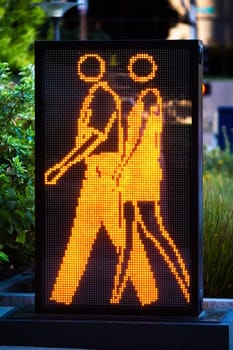
Like fellow members of the New British Sculpture movement, Anish Kapoor and Tony Cragg, Opie's work of the 1980s and 1990s rejected the trend toward Minimalism and Conceptual art that had dominated the sculpture scene in the 1970s. Somewhat paradoxically, he has gained international acclaim mostly for his minimalistic approach to portraiture. By reducing an individual's appearance to a few heavy lines, well-placed dots, and perhaps an extra defining feature or two, Opie has effectively invented a style of portraiture in which his subjects are effectively reduced to "logos" (of themselves).
Opie's preference for such a reductive simplicity has drawn some negative criticism. Art critic Christopher Allen, for example, has disparaged Opie's "limited repertoire of tricks", and the "slight and ultimately commercial, if not actually kitsch" nature of his work. Nevertheless, Opie's style has developed into a trademark. Arts editor John-Paul Pryor writes, "his work presents us all with a neutral and instantly recognizable evocation of the modern world, into which we are invited to feed our own psychological interpretations, thoughts and feelings. As such his minimalist aesthetic provides a powerful catalyst for a true experience of our own inner realities - an escape, if you like, from the artifice of reality we are faced with on a daily basis, and one which we can all employ to better make sense of the accelerated, advertising-saturated culture in which we are all, for better or worse, engaged".
Influences and Connections

-
![El Greco]() El Greco
El Greco -
![Joshua Reynolds]() Joshua Reynolds
Joshua Reynolds -
![George Romney]() George Romney
George Romney -
![Egon Schiele]() Egon Schiele
Egon Schiele ![Michael Craig-Martin]() Michael Craig-Martin
Michael Craig-Martin
-
![Chris Ofili]() Chris Ofili
Chris Ofili - Max Richter
- Fiona Rae
- Lisa Milroy
-
![St Ives School]() St Ives School
St Ives School -
![Pop Art]() Pop Art
Pop Art -
![Young British Artists]() Young British Artists
Young British Artists ![New British Sculpture]() New British Sculpture
New British Sculpture
-
![Chris Ofili]() Chris Ofili
Chris Ofili - Fiona Rae
- Lisa Milroy
- Blur
- U2
-
![Chris Ofili]() Chris Ofili
Chris Ofili - Max Richter
- Fiona Rae
- Lisa Milroy
-
![Pop Art]() Pop Art
Pop Art ![New British Sculpture]() New British Sculpture
New British Sculpture
 Ask The Art Story AI
Ask The Art Story AI